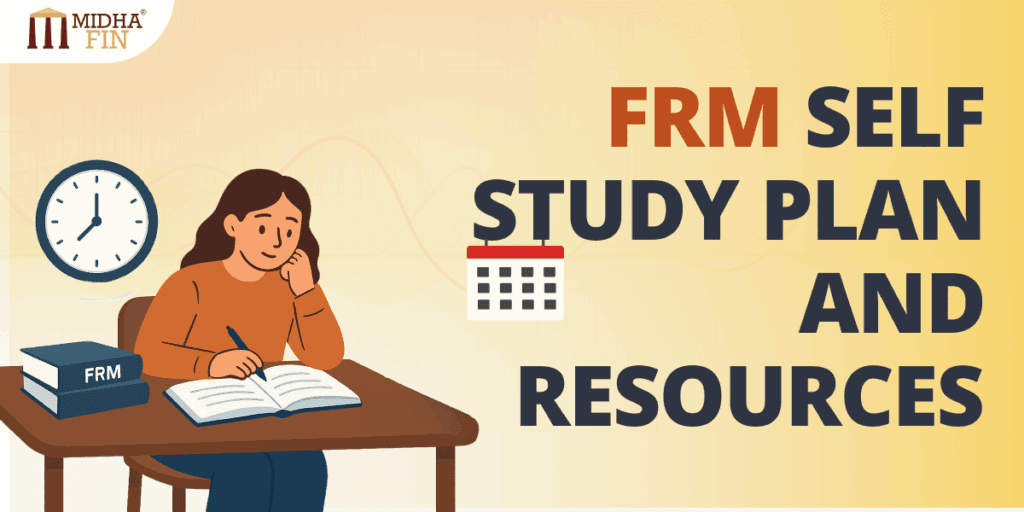Exam Preparation |
Finance Certifications
How to Self-Study for the GARP FRM Certification: What You Really Need for Part 1 and Part 2

So you’re thinking about taking the FRM exams — or maybe you’ve already registered — and you’re wondering: Can I really do this through self-study?
The answer is a big yes. Many candidates clear both Part 1 and Part 2 entirely on their own, without joining any coaching program. But make no mistake — it demands solid discipline, a clear plan, and the right mix of materials.
In this blog, let’s break down exactly what you’ll need, how to structure your prep, and some honest tips to help you succeed.
📚 The essential study materials you’ll need
1️⃣ Official GARP Books
If there’s one resource you should not skip, it’s the official books from GARP.
They are directly mapped to the exam Learning Objectives (LOs) and guarantee that you’re covering the syllabus exactly the way GARP wants.
- Pros: They are comprehensive and authoritative. You won’t miss any topic, especially critical for theory-heavy areas like Operational or Liquidity Risk (more relevant in Part 2).
- Cons: They can be quite dense. The language is often academic, so it might take time to get used to.
Even if you plan to use third-party notes, keep the GARP books handy for cross-reference.
2️⃣ Question Banks
You cannot just read your way through the FRM. Practicing questions is non-negotiable.
Aim to solve at least 2,000–2,500 questions per part across all topics. This sharpens your application skills and exposes you to the variety of questions GARP might throw at you.
- The GARP books have chapter-end practice questions, which are a great start.
- But you’ll likely need an external question bank too (from providers like Schweser, Bionic Turtle, etc.), especially for quantitative-heavy topics.
3️⃣ Short Topic Tests
Build the habit of taking short, timed quizzes after completing each topic.
This does two things:
- Improves recall for theory-dense chapters.
- Helps identify weak spots early, so you can plug them well before the final stretch.
A weekly mini test (even if it’s just 20-30 questions) makes a huge difference.
4️⃣ Full Mock Exams
Mocks are your rehearsal for the real thing. Try to do at least 4–5 full-length mocks under strict timed conditions, especially in the last 6–8 weeks.
After each mock:
- Review every mistake thoroughly.
- Note down topics that tripped you up.
- Revisit the concept, do a few targeted questions, then move on.
This cycle builds exam stamina and boosts confidence.
🗓️ Structuring your self-study journey
A common question is: How many hours do I need?
Realistically, plan for about 600 hours per part. Spread this over 6 to 9 months, depending on your daily availability.
Here’s a rough example:
- ✅ First 3–4 months: Cover the syllabus once, chapter by chapter. Solve end-of-chapter questions immediately after reading.
- ✅ Next 2 months: Start heavier question practice + small topic-wise tests.
- ✅ Last 2 months: Shift to mock exams, deep revision, and final weak-area fixing.
Important:
- Do not postpone questions to the end. Solve them alongside theory.
- Keep buffer weeks in your plan to account for work or personal emergencies.
💡 Useful free resources to structure your prep
Want a clear week-by-week path?
You can explore these free 20-week study plans we’ve built for working professionals:
- 📘 FRM Part 1 Study Plan – https://frm.midhafin.com/part-1/study-plan
- 📙 FRM Part 2 Study Plan – https://frm.midhafin.com/part-2/study-plan
They break down the syllabus into small weekly targets so you always know what to focus on.
🔥 Bonus: Free crash course for Part 1
If you’re just getting started or still testing the waters, check out this Free FRM Part 1 Crash Course – https://www.frm.midhafin.com/part-1/crash-course
It includes:
- Video lectures
- PDF study notes
- Sample practice questions
It’s a good way to get a feel for the exam style before committing full force.
👀 Can you really clear FRM without coaching?
Absolutely. Coaching gives structure, motivation, and ready-made doubt support. But self-study works brilliantly if you’re disciplined.
Here’s what successful self-study candidates typically do:
- Build a strong daily routine, even if it’s just 2 hours on weekdays + 4-5 hours on weekends.
- Stay consistent. Even short daily study beats long erratic sessions.
- Avoid just memorising — understand why a formula works or why a risk measure behaves a certain way.
- Use forums (like r/FRM on Reddit) to see how others are approaching problems.
🚀 Quick final tips
✅ Aim for roughly 600 hours per part
✅ Combine theory + questions right from the start
✅ Do short quizzes weekly
✅ Target 4–5 mocks under timed conditions
✅ Keep revisiting weak areas instead of just reading your favourite topics
Many candidates have cleared FRM with full-time jobs, from non-finance backgrounds, and entirely through self-study. So if you stay organised, you can absolutely crack it too.
🎯 Ready to start?
Whether you build your plan completely solo or use structured resources, what matters is consistency.
Stay at it, and in a few months, you’ll be amazed how much you’ve mastered.
If you want more tailored guidance or a week-by-week plan, feel free to reach out. Happy to help you navigate your FRM journey.
